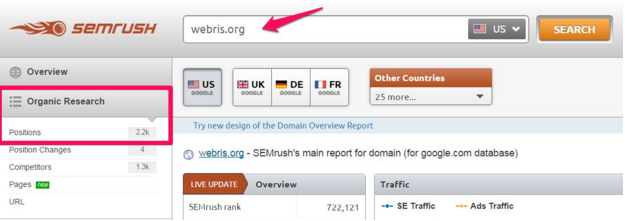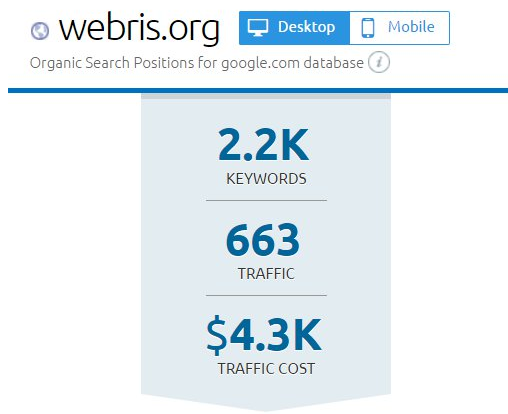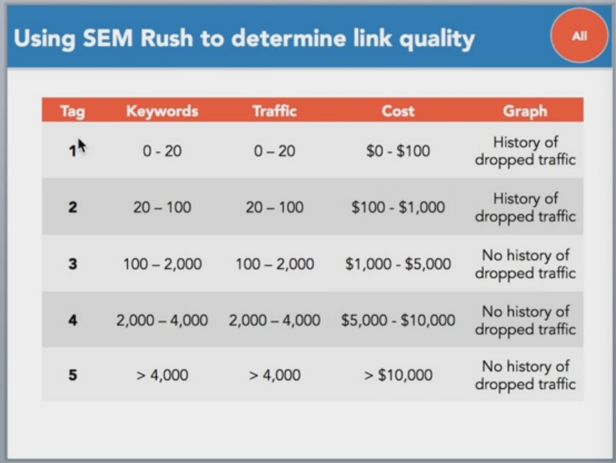
This is a guest post by Ryan Stewart, who first came to attention from me with his great blog post on Moz.com, Why I Stopped Selling SEO Services and You Should, Too
Link building is about one thing: driving traffic.
That’s it. Mostly.
So what about link building using social media?
I see a lot of sites actively marketing themselves through social media, and I get it. From a purely business point of view, any link that drives traffic to your site is a good link. Traffic is traffic, and social media can bring it in.
However, from a traditional SEO view, those kinds of links lack the domain authority and trust flow (often less than five) and wouldn’t be considered a good link.
Search engines crawl between websites through links, so it’s easy for them to measure how much traffic is passing through a link. And that’s the measurement you want to tap into.
Measure The True Metrics
SEM Rush, a paid subscription service, is my favorite link building tool.
There are a lot of third party tools that promise to help you measure traffic with their own custom metrics–domain authority, or trust flow, for example–but what you need to be measuring are the metrics from Google, Bing, and Yahoo. Third party metrics are fine–don’t get me wrong–but they aren’t true metrics from search engines and they aren’t as useful for link building.
SEM Rush is the place I go to measure what the search engines are measuring, and it’s what I use to help me determine which websites are a good target for my link building efforts.
SEM Rush has the ability to gather a lot of data, but for determining link quality, it is particularly easy to use:
- Take the URL from the website you are targeting for link building, and paste it into the top search bar.
- Click on “Organic Research” on the left-hand side and a drop down menu will appear.
- Click on “Positions” from the dropdown.

On your screen, you’ll see lots of data with an at-a-glance graphic, as well as a traffic and keyword chart. (Click on “Try new design of Organic Search Positions” if your screen is different than the screenshot below.)

You will do these few steps for each website you are researching, concentrating on the information provided on this one screen. From here, you can use a simple three-step process to streamline your link building program.
1. Look At A Site’s Link Quality
The first step is the main step: figuring out which sites have high quality links.
There are a few things we need to look at to determine that link quality, and SEM Rush makes this information pretty easy to find. The questions you’ll need answers for are:
- How many keywords is that website ranking for?
-
How much traffic does that website have?
-
What is the cost of that traffic? (This is calculated by how much it would cost to pay for that traffic via Google adwords.)
SEM Rush creates a graphic that tells you these three things at a glance.

If you figure that keywords are approximately a few cents each, you can do some rough math and figure out how much the traffic costs per keyword.
The main thing, though, is you want to see more keywords, more traffic, and higher cost. For the three metrics in this graphic, the higher the better. Any potential links that you might end up placing on such a site, whether through guest blogging or other methods, can drive lots of traffic back to your site as well as increase ranking.
We’re going to come back to link quality in the third step, when we get to prioritizing our link building targets.
2. Look For Clean Domain History
Next, you want to find out whether the website you’re targeting is clean.
Look at the graph located to the right of the link quality graphic we just talked about. This graph shows traffic or keyword rankings over time.
A huge spike and then a sharp plummet is not a good sign. A spike and a huge crash means the domain could be potentially toxic. It has stopped growing and its traffic is drying up. Mostly likely, it was penalized for shady activity in the past.

What you want to see is a graph that shows the domain moving up and to the right, like the screenshot below.

A graph like this shows a site that is actively gaining traffic and actively marketing itself. Sites with these types of graphs are ones you want to place on the top of the list for link outreach.
3. Prioritize Your Efforts
Now that you know the quality a potential link has, and how healthy a domain is, you’re ready to prioritize.
But first: even if a website has low traffic or evidence of traffic drops, you may still want to work with them.
The point in searching out quality is so that you can prioritize your outreach efforts and make better use of your resources, not to avoid connecting and networking with other sites. High quality websites always go first because they have the most impact on your site’s SEO rankings, but don’t write off the other sites.
So, what is a high quality site? It’s a site with lots of keywords, lots of traffic, and a high cost for traffic with a clean and steadily growing history for its domain.
To target the high quality links first, follow a few simple steps.
1. Set standards based on link quality.
Set a standard between 1 and 5, with 1 being the lowest, signifying a link that isn’t as powerful, and 5 being the highest with a powerful link and your ideal target. Use the chart below as a guide to help you categorize the link quality from your SEM Rush research.

These rankings will be your tags for each link.
For sites that have a mix of rankings, such as level 3 keywords but level 2 traffic and cost, you would assign a level 2 ranking. Essentially, you’re trying to average out the data to determine the best quality ranking for each site. It’s especially important to honor the traffic history (i.e. if all the data is a 3 ranking, but there is a traffic drop, the true ranking for that site will be a 2).
2. Track rankings and interactions.
Create a spreadsheet in which you track the name of the site, the status of your contact and interaction with the site, the numerical tag ranking, the type of link you’re requesting (e.g. guest post), and the site URL.
Our concern here is tag each target domain for the quality of the link.
The tags can be used for different reasons other than just easily identifying top targets. For example, they can be used to assign writers for your guest blogging program. To get a guest post on a site with a 5 ranking will need a higher quality writer (which will cost more), while a 1 will not.
Once you have the sites prioritized and tagged using the SEM Rush data, you’re able to pursue successful link building without wasting time and basing your actions on guesses.
Wrapping it up
There’s a lot of information on the web about how to build links the “right” way. While a lot of SEO metrics like Domain Authority, Trust Flow and Citation Flow are helpful, they aren’t Google’s metrics. Simplify your efforts by focusing on one thing: building links that drive traffic!
